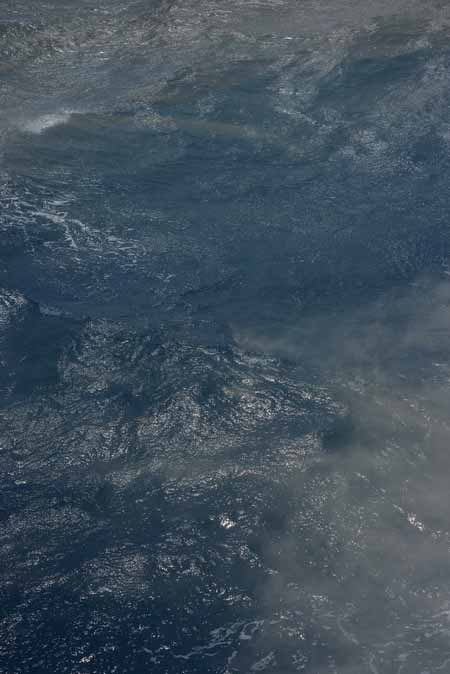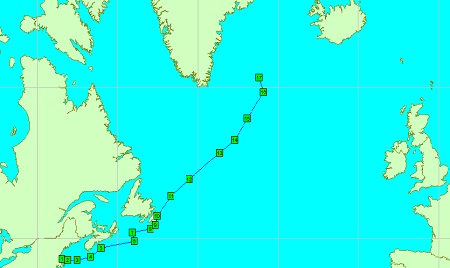There was a faint smell of black spruce drifting across the water, on the night before we landed in Newfoundland. I didn’t notice the smell dissipating when we departed a day later, but it must have lasted longer than our view of the coastline. St. John’s disappeared quickly behind us, as we sailed into a thick white fog. Condensation appeared on the sails, the deck, in the cockpit. Visibility dwindled to twenty meters or less. On that first night, as I fell asleep, we were suspended between a cloud of fog and a thousand meters of black water, far from shore, moving towards Iceland at jogging speed.
The fog was still opaque when I started my morning watch, but it lifted as we crossed an abrupt change in underwater elevation. Within a few minutes, Brian, our skipper, spotted a blow… then another and another. We gradually realized that we were surrounded by whales. In one direction a small group of humpbacks lounged at the surface. On the other side, a dozen pilot whales moved slowly past, with a few dolphins jumping among them. Fifty meters from the bow another humpback appeared, and did a slow dive as we approached. We passed over a smooth circle of water where it had been. Within an hour, we were back in the cloud, alone again. The winds increased, we spent the night surging through a cold, gusty fog. The next day it lifted for good, as the winds steadily increased and became a gale. We turned downwind, the large waves became more organized, and it began to feel as if we were moving with a large herd of white caps, stretching to the horizon in all directions. After another day of winds gusting up to 47 knots, the herd grew confused, with waves up to four meters.
One of the great things about Song of the Whale is that everyone on board does everything that needs to be done. We all take turns on helm, cooking, cleaning, listening to the hydrophones, recording observations etc. My favourite ‘chore’ is listening to the hydrophones, which is done for two minutes, every fifteen minutes, continuously.
It’s a strange feeling to look out onto empty ocean, with headphones on, listening to the sounds of animals that you can’t see, knowing that you’re not listening to a recording, but something that’s happening right now, all around you, out of sight. The sound is much more airy, much lighter than I expected. I guess I thought that things would sound murky or muffled, the way they do when I’m swimming. The dolphins sometimes sound like dozens of invisible birds, whistling and chirping. We passed another small pod of pilot whales, and listened as they inspected the hydrophones, 400m behind us. They sounded something like kittens mewing, but more content, slower and deeper. Sperm whales make a sound that I find very interesting because I imagine I’m hearing their personality in the slapping clicks they make. It’s a very practical, methodical sound, that quickens and seems to get slightly excited as they hone in on their prey in the dark depths. There’s a satisfied pause, when they might be chewing with their eyes closed… and then the slow clicks begin again. When there are more than two sperm whales, the clicks begin to sound playful, like a children’s hand clapping game. While we’re under sail, which has been most of the time, I’m content to sit and listen to the water moving past the hydrophones. Besides the odd trickling, the prevalent sound reminds me of a gentle wind, or wind and soft rain hitting leaves, in gusts. It’s a very pleasant sound.
Calm seas have returned and Song of the Whale is now entering the historical right whale hunting grounds southeast of Greenland called Cape Farewell, where North Atlantic right whales have been spotted few times in the last few decades. Observations begin earlier and earlier as the days grow longer. We’re all watching and listening attentively, hoping to encounter a right whale before we arrive in Iceland next week.
Eamon
Photographer Eamon Mac Mahon has joined the SOTW team as Artist in Residence as part of our on-going collaboration with Cape Farewell.


[…] Mac Mahon became involved with Cape Farewell as an invited participant of The Carbon 14 Workshop in November 2011. In July 2012, Mac Mahon joined the crew of the research vessel the Song of the Whale, for a 23-day sailing expedition from Boston to Iceland. The main purpose of this journey was an extensive acoustic survey in search of the rare and elusive North Atlantic Right Whale. Read about his experience here. […]